Development and Characterization of an Advanced Voltage-Controllable Capacitor Based on AlInGaN/GaN-Si (111) Epitaxy
Abstract
:1. Introduction
2. Device Design and Manufacture
3. Test and Discussion
4. Conclusions
Author Contributions
Funding
Institutional Review Board Statement
Data Availability Statement
Conflicts of Interest
References
- Sun, H.; Marti, D.; Tirelli, S.; Alt, A.R.; Benedickter, H.; Bolognesi, C. Millimeter-wave GaN-based HEMT development at ETH-Zürich. Int. J. Microw. Wirel. Technol. 2010, 2, 33–38. [Google Scholar] [CrossRef]
- Mishra, U.K.; Parikh, P.; Wu, Y.F. AlGaN/GaN HEMTs-an overview of device operation and applications. Proc. IEEE 2002, 90, 1022–1031. [Google Scholar] [CrossRef]
- Palacios, T.; Chakraborty, A.; Rajan, S.; Poblenz, C.; Keller, S.; DenBaars, S.; Mishra, U. High-power AlGaN/GaN HEMTs for ka-band applications. IEEE Electron Device Lett. 2005, 26, 781–783. [Google Scholar] [CrossRef]
- Chung, J.W.; Hoke, W.E.; Chumbes, E.M.; Palacios, T. AlGaN/GaN HEMT with 300-GHz fmax. IEEE Electron Device Lett. 2010, 31, 195–197. [Google Scholar] [CrossRef]
- Palacios, T.; Dora, Y.; Chakraborty, A.; Sanabria, C.; Keller, S.; DenBaars, S.P.; Mishra, U.K. Optimization of AlGaN/GaN HEMTs for high frequency operation. Phys. Status Solidi A 2006, 203, 1493. [Google Scholar] [CrossRef]
- Higashiwaki, M.; Mimura, T.; Matsui, T. AlGaN/GaN heterostructure field-effect transistors on 4H-SiC substrates with current-gain cutoff frequency of 190 GHz. Appl. Phys. Express 2008, 1, 021103. [Google Scholar] [CrossRef]
- Kumar, V.; Lu, W.; Schwindt, R.; Kuliev, A.; Simin, G.; Yang, J.; Khan, M.A.; Adesida, I. AlGaN/GaN HEMTs on SiC with fT of over 120 GHz. IEEE Electron Device Lett. 2002, 23, 455–457. [Google Scholar] [CrossRef]
- Christy, P.D.; Katayama, Y.; Wakejima, A.; Egawa, T. High fT and fMAX for 100 nm unpassivated rectangular gate AlGaN/GaN HEMT on high resistive silicon (111) substrate. Electron. Lett. 2015, 51, 1366–1368. [Google Scholar] [CrossRef]
- Schwindt, R.; Kumar, V.; Kuliev, A.; Simin, G.; Yang, J.; Khan, M.; Muir, M.; Adesida, I. Millimeter-wave high-power 0.25-μm gate-length AlGaN/GaN HEMTs on SiC substrates. IEEE Microw. Wirel. Compon. Lett. 2003, 13, 93–95. [Google Scholar] [CrossRef]
- Dumka, D.; Lee, C.; Tserng, H.; Saunier, P.; Kumar, M. AlGaN/GaN HEMTs on Si substrate with 7 W/mm output power density at 10 GHz. Electron. Lett. 2004, 40, 1023–1024. [Google Scholar] [CrossRef]
- Makiyama, K.; Ozaki, S.; Niida, Y. InAlGaN/GaN-HEMT device technologies for W-band high-power amplifier. In Proceedings of the 2016 Lester Eastman Conference (LEC), Bethlehem, PA, USA, 2–4 August 2016; pp. 31–34. [Google Scholar]
- Lee, D.S.; Laboutin, O.; Cao, Y.; Johnson, W.; Beam, E.; Ketterson, A.; Schuette, M.; Saunier, P.; Kopp, D.; Fay, P.; et al. 317 GHz InAlGaN/GaN HEMTs with extremely low on-resistance. Phys. Status Solidi C 2013, 10, 827–830. [Google Scholar] [CrossRef]
- Tsai, P.; Nguyen, H.; Nagarajan, V.; Lin, C.; Dee, C.; Chen, S.; Kuo, H.; Lee, C.; Chang, E.Y. Enhancement-Mode High-Frequency InAlGaN/GaN MIS-HEMT Fabricated by Implementing Oxygen-Based Digital Etching on the Quaternary Layer. ECS J. Solid State Sci. Technol. 2022, 11, 085005. [Google Scholar] [CrossRef]
- Mukherjee, H.; Kar, M.; Kundu, A.J. Enhancement in Analog/RF and Power Performance of Underlapped Dual-Gate GaN-Based MOSHEMTs with Quaternary InAlGaN Barrier of Varying Widths. Electron. Mater. 2022, 51, 692–703. [Google Scholar] [CrossRef]
- Yaita, J.; Yamada, A.; Nakamura, N.; Kotani, J. Probing the effects of surface roughness and barrier layer thickness in InAlGaN/GaN HEMTs to improve carrier mobility. Appl. Phys. Express 2021, 14, 031005. [Google Scholar] [CrossRef]
- Sanyal, I.; Lin, E.S.; Wan, Y.C.; Chen, K.M.; Tu, P.T.; Yeh, P.C.; Chyi, J.I. AlInGaN/GaN HEMTs with high Johnson’s figure-of-merit on low resistivity silicon substrate. IEEE J. Electron Devices Soc. 2021, 9, 130–136. [Google Scholar] [CrossRef]
- Guan, H.; He, L.; Wu, J.; Zeng, Z.; Li, Y.; Deng, B.; Shen, G.; Li, W.; Wang, Y. Fabrication and Characterization of a Novel Varistor Based on AlInGaN/GaN Heterojunction Epitaxy on High Resistance Silicon (111) Substrates. IEEE Trans. Electron Devices 2022, 69, 4200–4205. [Google Scholar] [CrossRef]
- Lecourt, F.; Douvry, Y.; Defrance, N.; Hoel, V.; De Jaeger, J.; Bouzid, S.; Renvoise, M.; Smith, D.; Maher, H. High transconductance AlGaN/GaN HEMT with thin barrier on Si (111) substrate. In Proceedings of the European Solid-State Device Research Conference (ESSDERC), Sevilla, Spain, 14–16 September 2010; pp. 281–284. [Google Scholar]
- Aubry, R.; Jacquet, J.C.; Oualli, M. ICP-CVD SiN passivation for high-power RF InAlGaN/GaN/SiC HEMT. IEEE Electron Device Lett. 2016, 37, 629–632. [Google Scholar] [CrossRef]
- Yamada, A.; Minoura, Y.; Kurahashi, N.; Kamada, Y.; Ohki, T.; Sato, M.; Nakamura, N. 31 W/mm at 8 GHz in InAlGaN/GaN HEMT with thermal CVD SiNx passivation. IEEE Electron Device Lett. 2024, 45, 324–327. [Google Scholar] [CrossRef]
- Guan, H.; Shen, G.; Gao, B.; Zhang, H.; Wang, Y.; Wang, S. A study on the optimized ohmic contact process of AlGaN/GaN-Si MIS-HEMTs. IEEE Access 2021, 9, 9855–9863. [Google Scholar] [CrossRef]
- Zhu, G.; Kong, Y.; Zhang, K.; Yu, X.; Chen, T. InAlGaN ultra-thin barrier layer structure high frequency GaN HEMT device. Res. Prog. Solid State Electron. 2017, 37, 299–302. [Google Scholar]
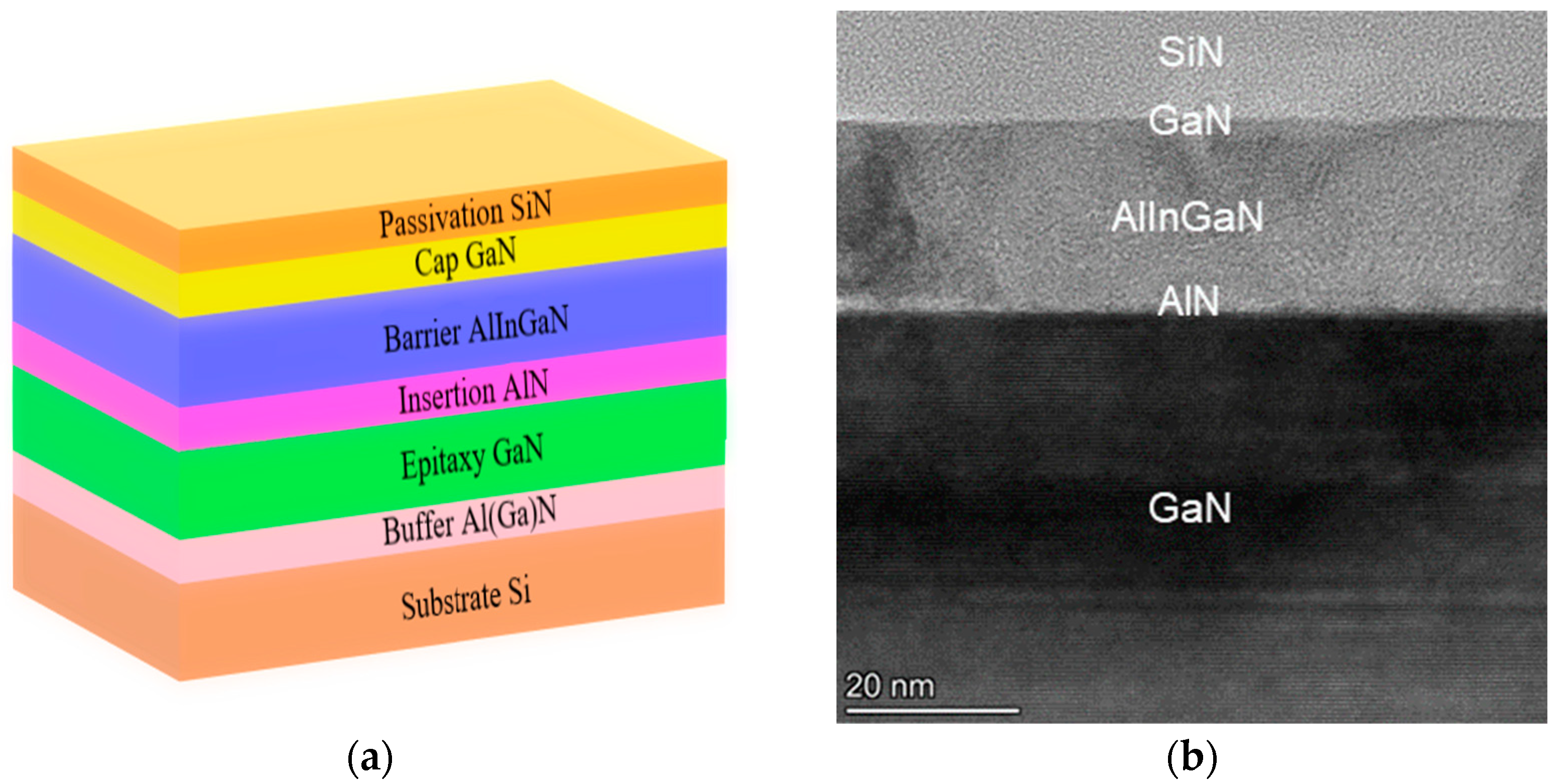

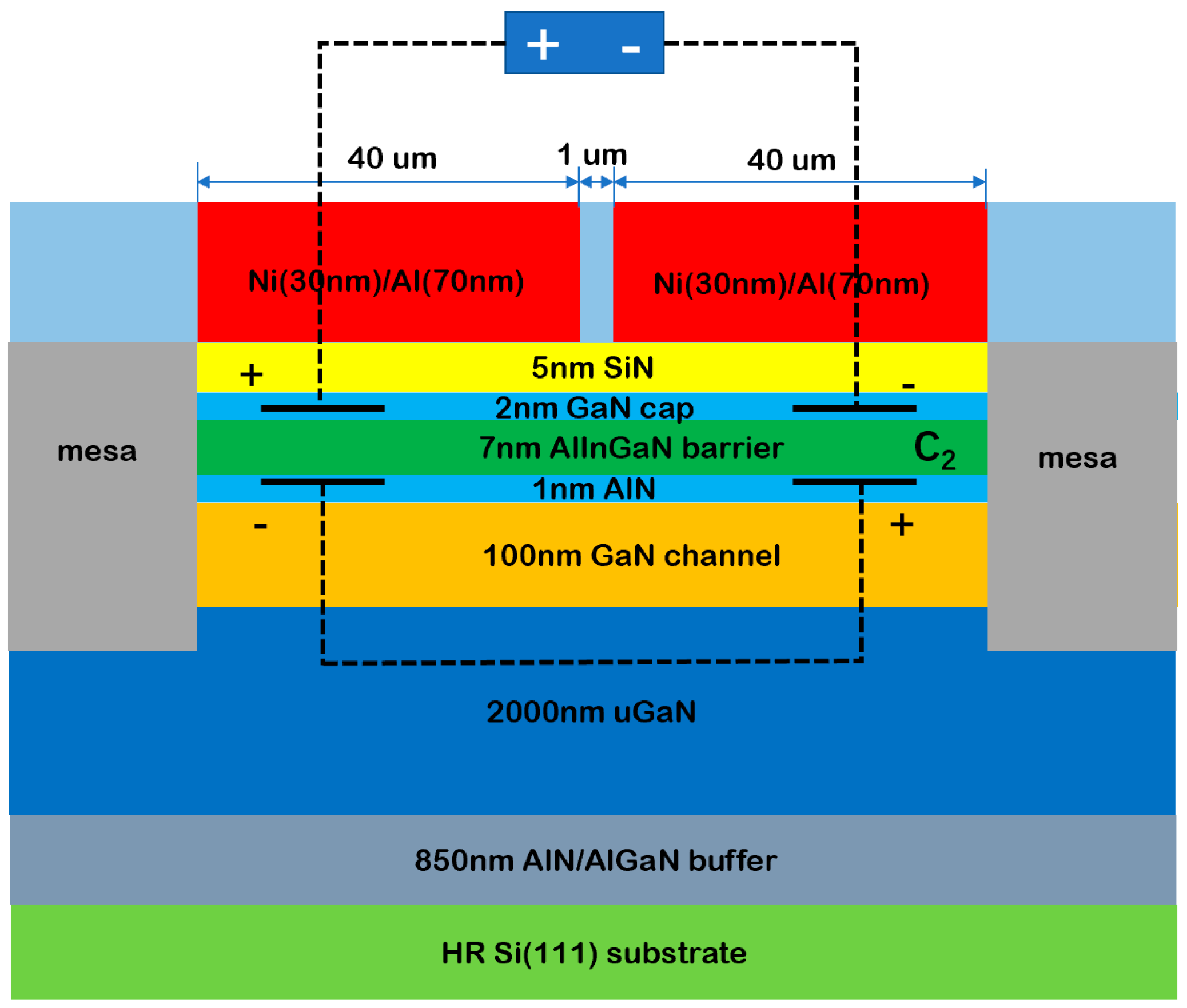
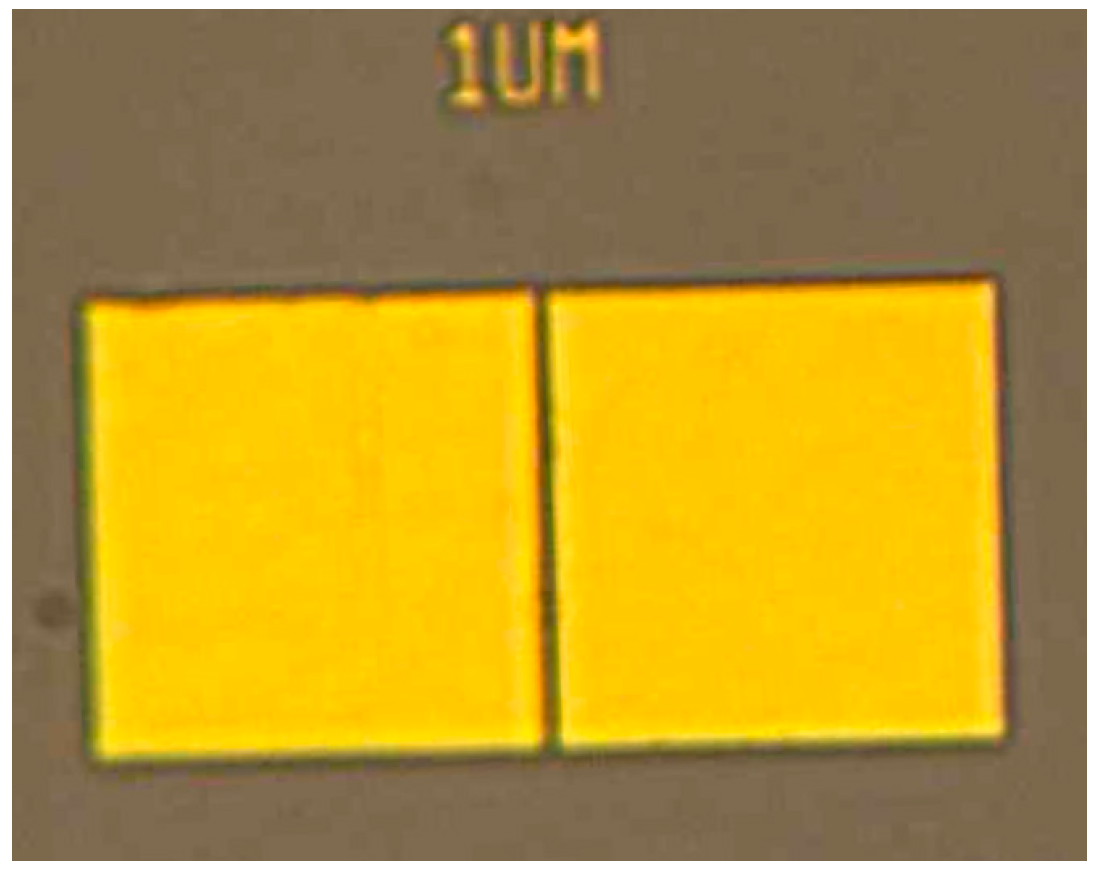
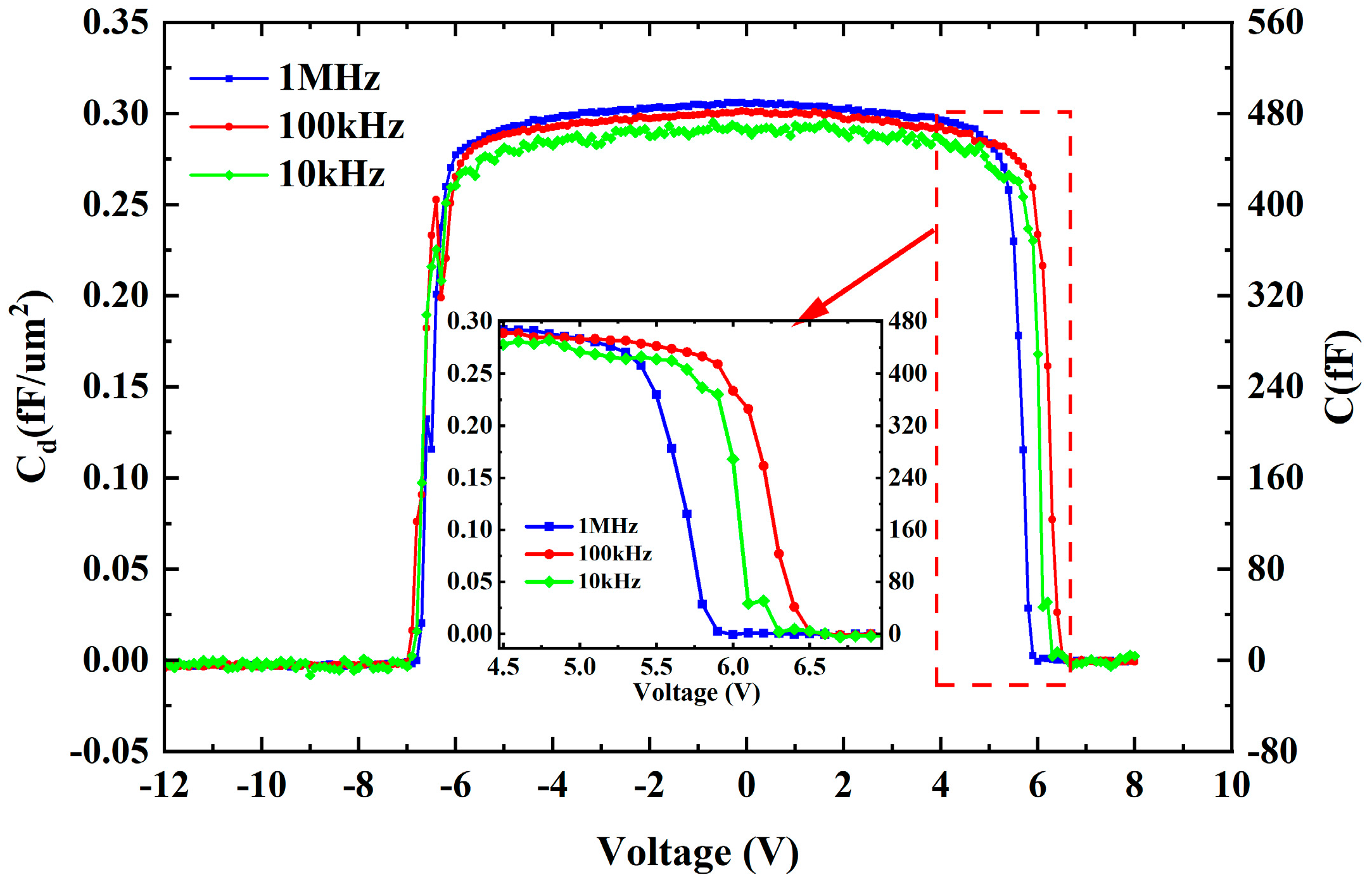
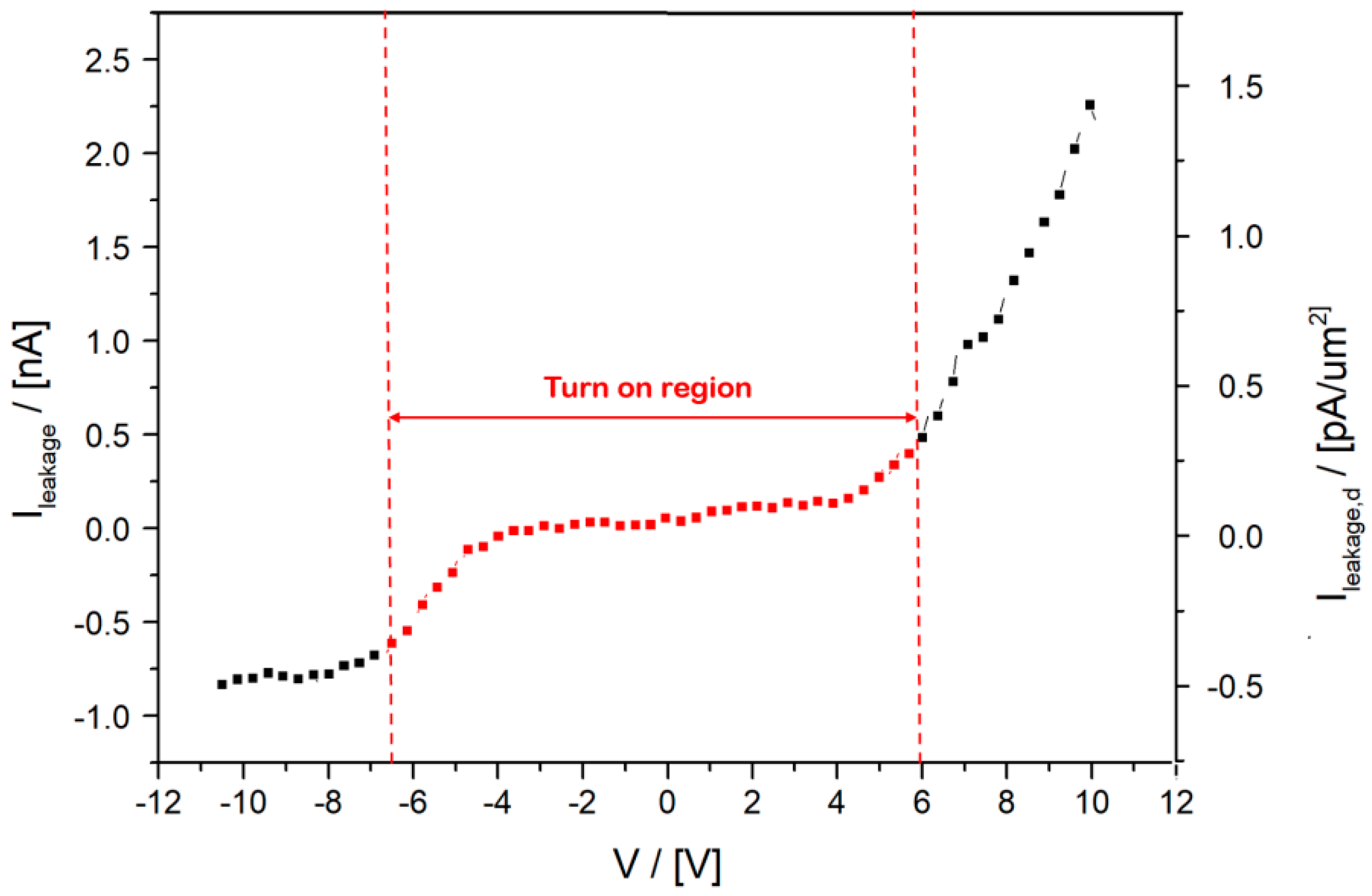
Disclaimer/Publisher’s Note: The statements, opinions and data contained in all publications are solely those of the individual author(s) and contributor(s) and not of MDPI and/or the editor(s). MDPI and/or the editor(s) disclaim responsibility for any injury to people or property resulting from any ideas, methods, instructions or products referred to in the content. |
© 2024 by the authors. Licensee MDPI, Basel, Switzerland. This article is an open access article distributed under the terms and conditions of the Creative Commons Attribution (CC BY) license (https://creativecommons.org/licenses/by/4.0/).
Share and Cite
Guan, H.; Shen, G. Development and Characterization of an Advanced Voltage-Controllable Capacitor Based on AlInGaN/GaN-Si (111) Epitaxy. Coatings 2024, 14, 1254. https://doi.org/10.3390/coatings14101254
Guan H, Shen G. Development and Characterization of an Advanced Voltage-Controllable Capacitor Based on AlInGaN/GaN-Si (111) Epitaxy. Coatings. 2024; 14(10):1254. https://doi.org/10.3390/coatings14101254
Chicago/Turabian StyleGuan, He, and Guiyu Shen. 2024. "Development and Characterization of an Advanced Voltage-Controllable Capacitor Based on AlInGaN/GaN-Si (111) Epitaxy" Coatings 14, no. 10: 1254. https://doi.org/10.3390/coatings14101254





